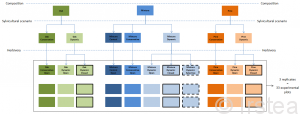Forests are currently subjected to environmental pressures induced by climate change, more dynamic forest management practices and increasing wild ungulate populations. Concerning climate change, rising temperatures is forecasted by all models, however precipitation models are more uncertain. For France, the 2071-2100 horizon, an increase of rainfall is expected in winter and more severe droughts in the southern parts of the country that can be extended to the whole country. In parallel, French policy encourages increased timber harvest in order to reduce uses of fossil fuels. Besides, an increase of the three main species of wild ungulates (red deer, roe deer and wild boar) has been observed during the last thirty years. These three major pressures may increase the vulnerability of French forest independently of each other or in interaction with each other through multiple pathways. We aim to increasing the knowledge and understanding of how these pressures affect forest ecosystem functioning.
Irstea, Research Unit Forest Ecosystems, has installed an experimental and equipped forest site called OPTMix (Oak Pine Tree Mixture), in the largest state forest of France (Orleans state forest in Central France). OPTMix consists of a network of 33 plots of either pure sessile oak (Quercus petraea), Scots pine (Pinus sylvestris), or a mixture of both tree species selected in even-aged lowland temperate forest stands of 60-80 years old. The experiment consists of a partially crossed factorial experiment (stand composition, tree density and herbivory). Stand composition (pure oak, pure pine and oak-pine mixture) and tree density (low and medium) have a completely crossed factorial design, while herbivory (fenced and unfenced) is completely crossed with stand composition only for the low tree density. Low tree density corresponds to a “dynamic management strategy” (target Relative Density Index of 0.4), and medium tree density to a “conservative management strategy” (target RDI of 0.7). The combinations of the factors tree density and herbivory corresponds to three unique management strategies (low density without herbivory, low and medium density with herbivory). The experiment is set up with three repetitions for each unique combination of factors with a total of 27 plots (3 compositions x 3 management strategies x 3 repetitions). We added for the mixed stands two management practices (corresponding to 6 plots): low tree density with access for wild boar but not deer (selective fences) and control stands without any harvest (with the aim to study self-thinning process). Each plot is 0.5 ha with a 20 m-wide buffer zone surrounding the plot and managed in the same manner as the plot. Many plots are equipped with sensors measuring microclimate, soil water content, water table, rainfall, light, etc. All plots have been characterized in terms of soil type, vegetation cover and diversity, dendrometric parameters. The experimental design allows the assessment of additive and interactive effects of stand composition and management practices on forest ecosystem functioning.





